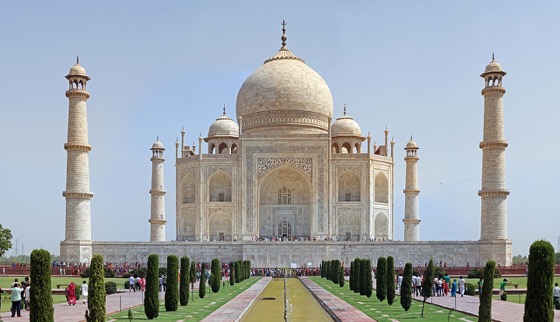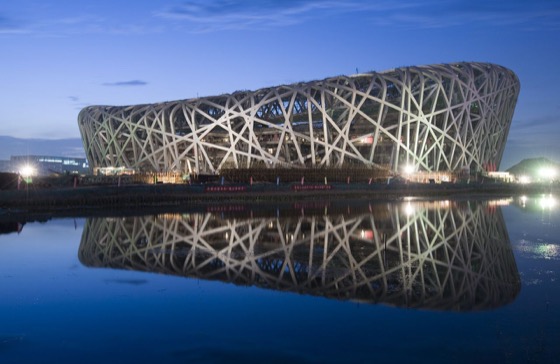Every so often, I hear teachers saying “I’d love to incorporate more about architecture, but I have no idea where to start!” Well, fear no more! I’m here to tell you that it’s not even that difficult; you can easily use some of these buildings with lessons you are probably already teaching. This list has contemporary engineering, ancient architecture, and everything in between. The only commonality is each of the 10 can be brought into your classroom and seamlessly added to your teaching repertoire. Here we go!
Parthenon on the Acropolis by Iktinos and Kallikrates
Athens, Greece

If you teach perspective, the golden section/golden mean, or anything about ancient architecture, the Parthenon is the way to go. There is math, there is sculpture, there are construction techniques used to offset natural optical illusions. This building offers so many connections to so many other disciplines. The image source link above is a great resource if you’re unfamiliar with these connections.
Sydney Opera House by Jorn Utzen
Sydney, Australia

When challenging students to work with repetition and/or form, the Sydney Opera House is a great reference. It’s striking, it’s unique, and it immediately captures the interest of a classroom full of students. It can be used for a discussion on expression, and how expressive drawing can be turned into expressive form or expressive architecture.
Fallingwater by Frank Lloyd Wright
Mill Run, Pennsylvania

A lot of teachers look at the work of Andy Goldsworthy, and a lot more do nature-inspired sculpture and drawing lessons. Why not take those ideas to the next level by incorporating architecture and nature? And what better building to reference than Frank Lloyd Wright’s Fallingwater, which just happens to be BUILT ON TOP OF A WATERFALL! Wright’s innovation and design, integrated with the natural surroundings, make it a perfect fit for mixing architecture and nature. Can you build into a mountain? On top of a tree? Underwater? Your kids can come up with so many great ideas designing buildings that interact with our natural world.
Hancock Tower by Henry N. Cobb
Chicago, Illinois

If you are creating architectural drawings, most likely you will need to do some work with 3-point perspective. This building was BUILT to be drawn in 3-point perspective! Wider at the base, then tapering inward as it rises, the Hancock Tower has been a minimalist beacon on the Chicago skyline since it was built. Protip: when you’re visiting Chicago, skip the Sears Tower (now called the Willis Tower) and hit the Hancock’s Observation Deck instead. The view is so much better, and you can go have super expensive drinks on the 96th floor. 🙂
Burj Khalifa by Adrian Smith, et al
Dubai, United Arab Emirates
Mile High Skyscraper by Frank Lloyd Wright

Let’s be honest. Most of your kids want to see who can build the tallest building possible. So let them try! Take a look at the Burj Khalifa, the world’s tallest building. Then, if you want to get theoretical, take a look at Wright’s 1950s designs for a Mile-High Skyscraper–almost twice as high as the Burj Khalifa–that Wright thought could have fit 100,000 people and featured 60-mph elevators that ran on atomic power.
The Pyramids at Giza

One of our first projects in my classroom is building three-dimensional forms out of paper, then learning to draw and shade said forms. We make things complex (dodecahedrons, anyone?) at times, but there’s nothing wrong with simple and classic. Most kids are familiar with this World Wonder, and it’s a great stepping-off point for discussing construction, form, and architecture.
Taj Mahal
Agra, India

Need Symmetry? Look at that picture. Need a mandala? Look at the floor plan. Calligraphy, Islamic Design, intricate modeling and architectural detail? Check, check, and check. Your students can add so much detail to their drawings and designs with the abundance of inspiration found in the Taj Mahal. Give the pictures a good look, because I guarantee both you and your students will find something of interest inside the building.
Bird’s Nest (Beijing National Stadium) by Jacques Herzog and Pierre de Meuron
Beijing, China

This stadium, which was the talk (amongst us architecture nerds) of the Beijing Olympics, creates an incredibly unique look with its overlapping strips of steel that form the exterior. Use this as a reference when you challenge your students to build a model, or a sculpture, using only strips of clay, paper, matboard, etc. incorporating some type of overlapping design.
Rolling Bridge by Thomas Heatherwick
London, England

When is a bridge not just a bridge? When it rolls into an octagon! This creative bit of engineering can springboard into some ideas about architectural creations that serve dual (or multiple) purposes at once.
Wave Field by Maya Lin
Ann Arbor, Michigan

We’ve seen architecture that incorporates nature, but what about architecture that is MADE from nature? Maya Lin changes the landscape on the University of Michigan campus by moving earth and creating a field full of waves. These waves are incredibly popular among students, who use them as places to study and read when the weather is nice. How could your students change the landscape itself and make it sculptural? Or functional?
I must admit I’m an architecture nerd (my father-in-law is an architect, so it’s kind of required), and I love everything involved with this list. However, even if you’re not quite at that level, I hope some of these buildings can light a creative spark that will begin to open up the world of architecture to your students.
What architecture projects do you do in your classroom? What buildings do you use as references?
Are there any architects or buildings we should add to this list?
Magazine articles and podcasts are opinions of professional education contributors and do not necessarily represent the position of the Art of Education University (AOEU) or its academic offerings. Contributors use terms in the way they are most often talked about in the scope of their educational experiences.





